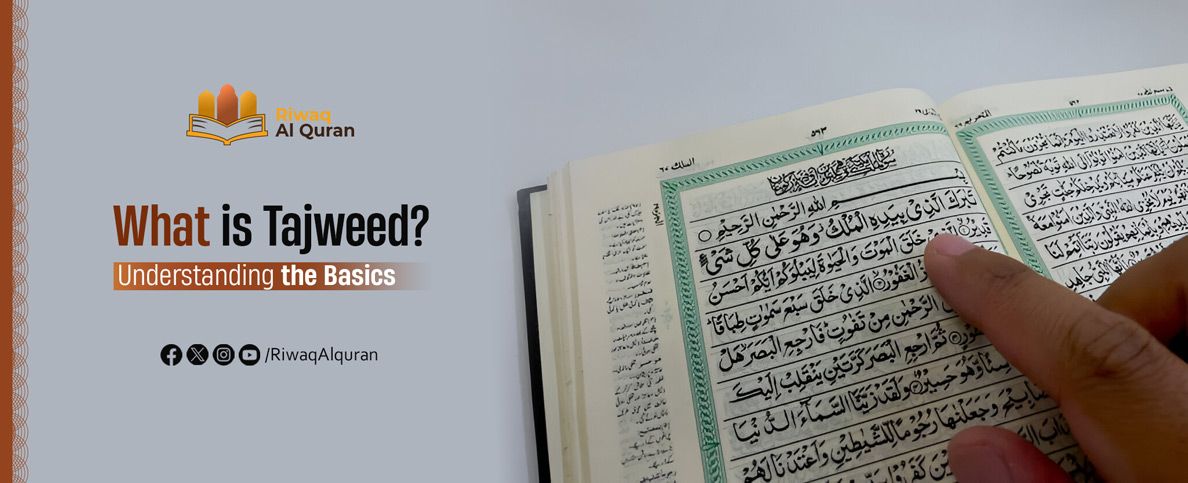The Quran is not only a source of divine guidance but also a beautiful text that deserves to be recited with care. Tajweed, the set of rules governing the proper pronunciation and recitation of the Quran, plays a crucial role in preserving its meaning and beauty.
This guide will explore the significance of Tajweed, its benefits, and effective methods for learning, making it an essential resource for anyone looking to improve their Quranic recitation and build a more meaningful relationship with Allah.
Table of Contents
Meaning of Tajweed:
Since Tajweed is an essential aspect of Quranic recitation that ensures the words of Allah are pronounced correctly and beautifully, let’s dive deeper into its meaning in the context of the Quran and linguistically:
Tajweed means to recite the Quran correctly according to the a set of rules. Tajweed refers to the science that teaches how to read the Quran beautifully and without mistakes by observing the Makhraj and characteristics of the Quranic letters and following the rules of Tajweed.
Tajweed in Arabic
The term “Tajweed” is derived from the Arabic root “جود,” which carries the meanings of perfection, enhancement, and beautification. It reflects the goal of Tajweed, which is to recite the Quran in the most accurate and melodious manner, adhering to the precise rules and guidelines that preserve its linguistic and spiritual integrity.
History of Tajweed
The origins of Tajweed can be traced back to the time of the Prophet Muhammad (PBUH). The Quran was revealed in a dialect specific to the Quraysh tribe, and the Prophet taught his companions to recite it in that exact manner. Early Muslims recognized the importance of preserving the correct pronunciation and meaning of the Quranic words, and over time, scholars began to develop specific rules to guide recitation.
Who Invented Tajweed?
Tajweed was not “invented” by any one individual but evolved over time through the collective efforts of Islamic scholars. The practice of perfecting Quranic recitation has existed since the time of the Prophet Muhammad (PBUH), but the rules and guidelines we follow today were developed by various scholars throughout Islamic history. Their aim was to ensure that the Quran was recited with the same accuracy, beauty, and melody as it was revealed.
The formalization of Tajweed into a structured set of rules was primarily done by early Islamic scholars who were concerned with preserving the Quran’s pronunciation and meaning. The contributions of scholars like Imam al-Susi, Imam al-Shatibi, and others helped establish the principles of Tajweed that are still followed today.
Benefits of Learning Tajweed
Learning Tajweed offers many benefits, enhancing both spiritual and personal growth. It deepens understanding of the Quran, fosters mindfulness during recitation, and builds a sense of community. The process develops patience and discipline while connecting individuals to the rich tradition of Islamic heritage and scholarship.
Why Is Tajweed Important?
Understanding Tajweed is crucial for proper Quran recitation. It preserves the meaning by ensuring accurate pronunciation, prevents misinterpretation, and enhances the beauty of recitation. Tajweed brings spiritual fulfillment, as it connects reciters more deeply with Allah’s words. It is also highly rewarded, with Hadiths emphasizing the reward for reciting beautifully.
How Many Types of Tajweed Are There?
Tajweed includes a set of essential rules that govern the pronunciation and articulation of Arabic letters, ensuring the Quran is recited accurately and beautifully. These rules can be divided into two main types as follows:
1. Sifaat and Makharij (صفات ومخارج):
These are the characteristics or attributes of the Arabic letters, such as whether the sound is heavy or light, sharp or soft. They help in producing the correct sound for each letter.
2. Ahkam (أحكام):
These are the rules governing the pronunciation and articulation of the letters, including rules for elongation, pauses, and merging or separating certain letters, to ensure correct recitation of the Quran.


Top Tajweed Rules and Terms
When discussing Tajweed, there are several key terms and rules that are frequently used to ensure proper recitation of the Quran. Below are some of the most important terms related to the Tajweed rules:
1. Madd (Elongation)
Madd refers to the elongation of certain vowels in the Quran, typically extending the sound for two to six counts, depending on the rule.
2. Idgham (Merging)
Idgham occurs when two letters are pronounced together smoothly, merging the sound of the first letter into the second, often found when specific letters follow each other.
3. Ghunna (Nasalization)
Ghunna is the nasal sound produced when certain letters are pronounced with a nasal tone, typically seen with the letters “ن” and “م.”
4. Qalqalah (Echoing Sound)
Qalqalah refers to the echoing or bouncing sound produced by certain letters when they are followed by a pause or stop, like “ق,” “ط,” “ب,” “ج,” and “د.”
5. Tafkhim (Heavy Pronunciation)
Tafkhim refers to pronouncing certain letters with a heavy or emphatic tone, such as the letters “ص,” “ض,” “ط,” and “ظ.”
6. Tarqiq (Light Pronunciation)
Tarqiq is the opposite of Tafkhim and involves pronouncing letters in a lighter tone, usually for softer-sounding letters like “س” or “ف.”
7. Izhar (Clarification)
Izhar occurs when a letter is clearly articulated, especially when pronounced in isolation without merging with the following letter, ensuring clarity and precision.
8. Sifaat Al-Huruf (Characteristics of Letters)
Understanding the specific characteristics of each letter, such as whether they are sharp or soft, which affects their pronunciation.
9. Waqf (Stopping)
The rule for stopping or pausing at specific points in the Quran to maintain the meaning and flow.
10. Ikhfaa (Concealment)
Ikhfaa is The partial blending of one letter with the next, often creating a smooth transition in pronunciation.

Rules of Meem Sakinah
Now the rules of noon Sakinah and Tanween are clear. But what are the Meem sakeen rules? Let’s take a look!
1- Ikhfaa Shafawy
It happens when a letter ba with movement comes after meem sakeen. Example:
2- Idghaam Mutamathelyne Sagheer
If a meem with movement (fatha, damma, or kasra) comes after a meem with no Harakah, this rule occurs. Examples:
3- Izhaar Shafawy
It occurs when any letters other than Meem and Baa come after the meem with no Harakah.
Tanween and Noon Sakinah
One of the main topics that form a large part of Tajweed is the rules of Noon Sakeen and Tanween. Let’s first start with their meaning and then learn the Tajweed rules with examples of all their types.
Tanween: It is called nunation when Tanween gives the sound of “an” at the end of the word with fatha, “un” at the end of the word with damma, and “in” at the end of the word with kasra.
Example:
As for Noon Sakeen: It is called Noon with Jazm without movement (Harakah). Tanween and Noon Sakeen are read in one of the forms Ikhfaa, Izhaar, Idgham, and Iqlaab according to the letters that follow them.
Is It Compulsory to Read Quran with Tajweed?
Since the Quran was sent down with its wording and meaning, it is Fard Kifayah to learn Tajweed in order to preserve its wording in its original form. Accordingly, it is sufficient for some Muslims to know the rules of tajweed. Those who know receive their reward, but those who do not know do not become sinners.
However, it has been deemed Wajib to follow the rules of tajweed while reciting the Quran in a way that avoids the clear mistakes, which occur when the letters in the verses we recite in prayer, especially in prayer, are corrupted.
Tajweed scholars have divided the mistakes made while reading the Quran into two:
- Lahn Jalee (Clear mistakes): These errors are errors such as misreading the letter and so on.
- Lahn Khafi (unobvious mistakes): Not applying Ikhfaa, Iqlab, Izhar, etc.
How Do I Read the Quran with Tajweed?
Have you learned the Tajweed rules but don’t know how to apply them? Here are some tips for you:
1- Listen to Quran Recitation with Tajweed
The more Tajweed rules you hear, the more you hear the sounds of the correct application of the rules, and the more you will remember the application of the rules. The Quran with the QR codes is very beneficial in this context today.
2- Write Down What You Learn
Circle the Tajweed rule you have learned in the Quran with a pencil and write down what it is. Repeat this tactic for the first few days. After a certain time, you will automatically recognize the rules InshaAllah.
3- Read the Quran Aloud
Reading aloud gets your mouth used to applying the rules, and it gets easier over time. The more you do this, the more you become able to detect your own mistakes and correct them.
4- Teach Someone Else What You Have Learned
When explaining it to someone else, you make an effort not to get things wrong, and this actually teaches you in the best way. You can also record yourself explaining the rules you learn and how to apply them.
Here is a beautiful story about Tajweed learning that teaches us the importance of Tajweed and how to master it.
How to Recite the Quran with Tajweed?
To recite the Quran properly with Tajweed, focus on the following:
- Seek Guidance from Qualified Teachers
- Learn the Rules of Tajweed Thoroughly
- Focus on Correct Articulation (Makhraj)
- Practice Regularly
- Recite Slowly and Clearly
- Listen to Professional Reciters
- Attend In-Person Classes
- Enroll in Online Courses
- Utilize Educational Resources
- Join Study Groups or Online Forums
- Get Feedback and Correct Mistakes
Read more about: The Advanced Tajweed Rules
How Long Does It Take to Learn Tajweed?
This process, which varies according to the learning speed of the person, can take between 2 months and 6 months on average and it may be shortened or prolonged depending on the person. Taking regular weekly lessons and allocating specific time for learning will increase productivity.
And again, one of the most influential factors in this process is a good guide. Getting support from someone who is experienced in teaching Tajweed is very important in terms of being able to apply what you have learned and being permanent. Remember, it is not about how quickly you learn, but how permanently you learn.
Riwaq Al Quran offers you the best Tajweed classes online with the availability to create your own study plan!
Is Tajweed Easy to Learn?
Well, learning to read the Quran in the most beautiful way with Tajweed is a process that requires effort, as every beautiful thing requires effort and patience. But in this process, your teacher choice is of great importance. For example, if you learn Tajweed from an Arab Quran Tutor simultaneously with Quran lessons, your ear will become more familiar with the native Arabic accent and Tajweed rules, making the process easier.
Riwaq Al Quran, the online Quran and Tajweed learning platform that appeals to all over the world, offers you fun and flexible Tajweed lessons where you will get fast results. Click to start free Tajweed lessons now!


Learn to Recite Quran Tajweed Properly With Us!
The process of mastering Tajweed requires continuous practice and review, and can be learned through accredited academies that offer structured programs, guiding students from beginner to proficiency in reciting the Quran correctly
Join Riwaq Al-Quran today and take the first step towards mastering the art of Quranic recitation. Enroll now and experience the beauty of reciting Allah’s words with precision and grace, while deepening your connection to the Quran and its timeless wisdom.
We offer several courses such as:
- Online courses for kids.
- Online Quran classes for kids and adults.
- Online Arabic courses
- Online Ijazah courses
- Online Islamic Studies courses.
Here are a sample of our set of Quran Courses that will be helpful for you:
- Online Tafseer Course: Delve into Quranic meanings with our insightful online Tafseer course.
- Noorani Qaida Online: Learn Quranic basics efficiently through our Noorani Qaida online program.
- Online Quran Recitation Course: Enhance Quranic recitation skills through our expert-led online course.
- Online Tajweed Classes: Master Tajweed rules for beautiful Quranic recitation in online classes.
- Quran Memorization Online Course: Memorize the Quran effectively with our specialized online memorization course.
- Online Qirat Course: Explore diverse Qirat styles with our comprehensive online Qirat course.
- Online Quran Classes for Kids: Nurture a love for the Quran in kids through interactive online classes.
Frequently Asked Questions
Here are some common questions about learning Tajweed and obtaining Ijazah. If you’re considering mastering the art of Quranic recitation, these answers will guide you on your journey.
1. Do I have to learn Tajweed?
Yes, learning Tajweed is essential for proper Quranic recitation, ensuring that the Quran is read with the correct pronunciation and meaning.
2. How to get Ijazah in Tajweed?
To obtain Ijazah in Tajweed, you must study under a qualified teacher, mastering the rules of Tajweed, and demonstrate your proficiency through assessment.
3. How long does it take to learn Tajweed?
The time required to learn Tajweed varies based on individual dedication, but typically it takes several months to a few years, depending on your learning pace and consistency.
Conclusion
Mastering Tajweed is crucial for proper and beautiful Quranic recitation, as it ensures the accurate pronunciation of Allah’s words while preserving the text’s linguistic and spiritual integrity. By learning Tajweed, you can deepen your connection with the Quran, enhance your understanding of its meanings, and earn spiritual rewards for your efforts. With consistent practice and the right guidance, you can achieve excellence in recitation and truly experience the beauty of the Quran.
At Riwaq Al-Quran, we provide expert instruction and structured programs designed to help you master the art of Tajweed. Our courses offer the support and resources you need to recite the Quran with precision and grace. Join us today and take the first step towards elevating your recitation and strengthening your relationship with the Quran.




































